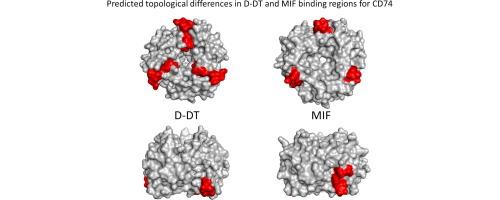Modeling of both shared and distinct interactions between MIF and its homologue D-DT with their common receptor CD74 |
| |
| Affiliation: | 1. School of Health and Biomedical Sciences, RMIT University, Australia;2. Department of Biochemistry and Molecular Biology, University of Melbourne, Australia;3. School of Biomedical Sciences, University of Queensland, Australia;1. Groningen Research Institute of Pharmacy, Department of Molecular Pharmacology, University of Groningen, Antonius Deusinglaan 1, 9713 AV Groningen, the Netherlands;2. Groningen Research Institute of Pharmacy, Department of Chemical and Pharmaceutical Biology, University of Groningen, Antonius Deusinglaan 1, 9713 AV Groningen, the Netherlands;3. University Medical Center Groningen, Groningen Research Institute of Asthma and COPD, University of Groningen, Hanzeplein 1, 9713 GZ Groningen, the Netherlands;4. Faculty of Pharmacy, Hasanuddin University, Makassar 90245, Indonesia;5. Division of Medicinal Chemistry, Amsterdam Institute of Molecular and Life Sciences, Vrije Universiteit Amsterdam, De Boelelaan 1108, 1081 HZ Amsterdam, the Netherlands;6. University Medical Center Groningen, Department of Pathology and Medical Biology, University of Groningen, Hanzeplein 1, 9713 GZ Groningen, the Netherlands |
| |
| Abstract: | 
D-dopachrome tautomerase (D-DT) shares amino acid sequence similarity, structural architecture and biological activity with the cytokine MIF. Recent studies show that the two protein homologs also bind to the same cell surface receptor, CD74, to activate the ERK1/2 pathway that ultimately leads to pro-inflammatory and pro-survival gene expression. We recently showed that RTL1000 and DRa1-MOG-35-55, two biological drugs with potent anti-inflammatory properties that treat experimental autoimmune encephalomyelitis (EAE) in mice, bind to the cell surface receptor CD74 with high affinity and compete with MIF for binding to the same regions of CD74. Computational modeling of MIF and RTL1000 binding interactions with CD74 predicted the presence of three CD74 binding regions for each MIF homotrimer. Through a similar approach we have now expanded our work to study the D-DT (MIF-2) interaction with CD74 that is mainly defined by three elements scattered throughout the disordered regions of the interacting molecules. The model predicted: (a) a hydrophobic cradle between CD74 and D-DT consisting of N-terminal tyrosine residues of three CD74 monomers arranged in a planar alignment interacts with aromatic amino acid residues located in the disordered D-DT C-terminus; (b) a triad consisting of the E103 residue on one D-DT monomer in close contact with R179 and S181 on one chain of the CD74 trimer forms an intermolecular salt bridge; and (c) amino acid residues on the C-terminus random coil of CD74 chain C form a long interacting area of ∼500 Å2 with a disordered region of D-DT chain B. These three binding elements were also present in MIF/CD74 binding interactions, with involvement of identical or highly similar amino acid residues in each MIF homotrimer that partner with the exact same residues in CD74. Topologically, however, the location of the three CD74 binding regions of the D-DT homotrimer differs substantially from that of the three MIF binding regions. This key difference in orientation appears to derive from a sequence insertion in D-DT that topologically limits binding to only one CD74 molecule per D-DT homotrimer, in contrast to predicted binding of up to three CD74 molecules per MIF homotrimer. These results have implications for the manner in which D-DT and MIF compete with each other for binding to the CD74 receptor and for the relative potency of DRa1-MOG-35-55 and RTL1000 for competitive inhibition of D-DT and MIF binding and activation through CD74. |
| |
| Keywords: | MIF D-DT CD74 Predicted binding interactions Inflammatory factors |
| 本文献已被 ScienceDirect 等数据库收录! |
|

